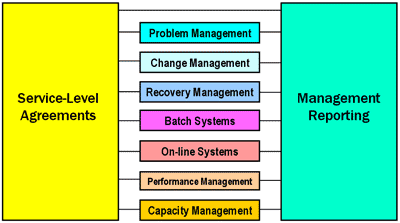Managing IT Operations

 Introduction
Introduction
The management of IT operations is concerned with ensuring that the IT production activity is delivering reliable, high quality results. Activities associated with IT operations include:
- Planning in terms of capacity, performance, alignment, and service level.
- Security, backup and disaster planning.
- Computer centre maintenance.
- Outsourcing
- Ongoing improvement of operations
Managing Expectations 
Fulfilling the expectations of executives – whether they are realistic or not - is the main standard for measuring managers’ performance.
However, expectations have many origins and are established by a variety of means. Some result from external sources – vendors, articles in magazines and trade publications, meetings and seminars etc. Internal factors also influence expectations – IT budgets, IT visibility within a company, and internal IT promotions.
Unfortunately, expectations may not always be soundly based. Such expectations can be difficult to control and often impossible to turn off. Therefore, given the importance expectations, organizations must use sound management techniques to help set and meet realistic expectations.
Service level agreements – which establish acceptable service levels for IT’s clients – is an important process to help an entire organization to clearly understand what is expected from and delivered by an IT (or computer) centre in a business.
System Operational Processes
System operational processes consist of the procedures, tools and people who are organized to manage important aspects of computer systems operations. Against these processes, service level agreements establish the client oriented performance criteria. Similarly, (process) specific reports provide the tools to inform the organization and clients of the status of the service, and the actions taken to correct problems.

To provide superior customer service, operations managers must be able to control and manage the following IT areas: 1
- Operational problems that decrease service level or increase resource usage.
- System-wide change control.
- Service disruption recovery plans.
- Plans for the routine scheduling, processing and delivery of results (both batch and online) to clients.
- Maintenance of system performance to meet service level agreements.
- Planned capacity to ensure that all the above system operational processes function correctly.
 Additional Operational Areas
Additional Operational Areas
An IT manager must be able to manage the technical and personnel aspects of operations. These include:
- Management skills, including change management, interpersonal skills, & negotiation.
- Acquisition of computing resources.
- Technology, hardware & software trends & issues.
- Network administration.
- Software licensing issues.
- Reporting
- Operational, tactical and life cycle planning.
- Financial management and budgeting.
- Performance monitoring and review.
 Managing Workload
Managing Workload
In managing workload, an operations manager must :
- Identify the essential tasks to be built into the organisation’s culture.
- Recognise that monitoring operations and production is important.
- Achieve a balance in the resource needs of development and operations.
- Be aware of problems at departmental and business level.
- Stay “cool” in a “hot” job, think laterally, and work together with other managers.
In particular, the operations environment can be difficult to manage where:
- There are unattended computer rooms that need to be monitored and controlled.
- There is an increasing use of devolved computing.
- Increasing computer power leads to increased complexity.
- Expert systems are used to automate computer operations.
- Staff are highly educated and expert, and believe that their solutions and their way of operating is the best available.
Setting Goals - The operational goals of a typical IT department are:
- To fulfil all job schedules within the allocated time.
- To handle any unexpected requests without compromising or impacting the scheduled tasks.
- To maintain the operational expenditure to within the agreed budget.
- To achieve zero defects so that all transactions are handled correctly.
Being Successful - A measures of a successful IT operation are where:
- The deadlines have been met.
- Work flows have been monitored throughout the key business areas of the organization.
- System failures have been rectified and recovered from within specified agreed timeframes.
- Problems have been overcome with minimum disruption to business processes.
Issues - Some of the issues that present difficulties when managing IT operations include:
- Slow response time for user support, reports, training etc.
- Incorrect data.
- Substandard or inadequate equipment.
- The threat of outsourcing and job loss.
- Under-funding,
- Declining staff expertise as salary caps are imposed.
Solutions - Some strategies (that have their own inherent problems) for addressing IT operations issues are:
- Buying more equipment, particularly if cost effective.
- Managing priorities to ensure that the important is not replaced by the urgent.
- Document and measure what is being done by the employees and the IT staff, identify the problems, and set standards to solve the problems.
- Use contract labour (which has its own problems).
- Hire equipment rather than purchase it.
Measuring Effectiveness - In IT operations there are two major measures of effectiveness:
- External effectiveness is what the customer sees and experiences. For example; slow response time, system down time, reports not available, inappropriate training programs. Such issues will have a direct impact upon the level of customer satisfaction.
- Internal effectiveness is what employees and management expect to be delivered. This includes usage as a % of capacity, software availability, system performance, response times, problem resolution, security and access control.
Critical Tasks - The critical tasks that require the attention of the IT operations manager are extensive. They include:
- Data centre operations
- Network management
- Financial management
- Technology management
- Security management
- Disaster recovery management
- Outsourcing
- Service level agreements
 Data Centre Operations
Data Centre Operations
A data centre is a facility where data is processed and/or stored. Efficient management of a data centre involves control of expenditure, the reduction of costs, and the management of:
- Functional quality in terms of customer satisfaction.
- Technical quality reflected in the ease of maintenance and how well applications run.
- Application age, where generally older applications are rated as less efficient.
- Business coverage in terms of how much of the business that can be automated, is automated.
An automated data centre is one that has eliminated the need for operators undertaking console monitoring, data entry, I/O control and manual media distribution. IT also eliminates the need for librarians, coordinators and help consultants. This is achieved by using the following to eliminate or automate manual operation:
- Computers that can operate unattended.
- Software that processes unattended, with a self correct facility.
- Interactive security.
- Batch & on-line processing that can operate unattended.
A help desk is a service location within a business that provides information, support action and on-demand advice to the IT users in a business.
A key objective for an IT manager is to transform the help desk into a strategic asset for the business. Such a help desk should be proactive, gathering and disseminating information that will provide detailed statistics on complaints, problems, and time related issues.
These functions should integrated into the IT system and provide a public face for the IT department. Help desk staff should be trained in customer service provision and offered career opportunities within the organization (rather than being marginalized as part-time or casual staff).
 Network Administration
Network Administration
Network administration is a set of management activities for the planning and development, installation, and the monitoring and maintenance of a complete network and its component parts. This is undertaken to ensure that specified service levels are achieved with a high degree of reliability budgeted cost limits. It is achieved by processes for:
- Fault finding and handling.
- Performance monitoring.
- Change management and tactical handling.
- Cost control.
 Financial Management
Financial Management
IT operations managers are constantly faced with the question: “Are we getting value for money?” In terms of the productivity and financial management of IT operations, there are three special responsibilities in addition to the normal financial responsibilities (of budgeting and the monitoring and control of expenditure):
- Containing costs.
- Return on investment (ROI) & other financial tools.
- Total cost of ownership (TCO).
There are a number of cost reduction strategies that can be adopted:
- Identify expenses that are continuous, but do not produce a benefit over the full expense cycle. For example – replace some fulltime employees with experts on short term contracts.
- Obtain precise requirements for software, so that any modification are specific and can be accurately costed.
- Use multiple copy software licences standard package usage throughout the business.
- Staff must provide a justification with a request for new software.
There are well established tools for managing investment.
- Return on investment (ROI) is the ratio of the annual net income from the project divided by the investment in that project.
- Net present value (NPV) is the sum of cash inflows less the present value. The NPV with the highest positive value is the most profitable project.
- Internal rate of return (IRR) uses the NPV to calculate the rate of interest at which the NPV is zero. This attempts to make projects directly comparable, and sets a hurdle.
- Payback calculates the length of time that a project will take to return the original investment.
Total cost of ownership (TCO) – in the context of IT operations – is all the costs associated ownership – capital purchase cost, maintenance, repair and administrative charges.
The objective of TCO is not to have precise measures – which are often too difficult to obtain – rather to use reasonable estimates of an IT asset’s value instead of only using the original purchase cost. Furthermore, the TCO can be used to provide a comparison between different platforms, based upon purchase price plus ongoing costs.
 Technology Management
Technology Management
Technology management is the effective use of available and emerging technologies based upon awareness of an organisation’s requirements, and an understanding of how to integrate new technologies into existing operations.
Managers face the challenge of taking advantage of new technologies while managing the inevitable personal and organizational problems. Their strategies must capture the technology’s advantages for their organization while mitigating the difficulties that arise.
Some examples of new technologies that present challenges to IT managers are:
- Wireless computing (or mobile computing) has much publicity as the next wave in business computing. Where the benefits of mobility align with a business’s strategy, the role of the IT manager is to cost the migration to wireless and offset it against the expected benefits (and risks – e.g. security).
- Data warehousing is the use of a database system to perform complex queries across multiple sources of data. The IT manager must be aware of changing business needs for data, and react accordingly to growth or change.
 Security Management
Security Management
Security is primarily a management issue, not a technology issue.
There is a strong tendency for senior management – and some IT management – to think of security in terms of firewalls, antivirus programs, and other technology solutions.
This is very dangerous because without excellent management, operational procedures, and implementation diligence, the best technology will make no difference.
The core security goals for the management of IT operations are based on three dimensions:
- Confidentiality – which means that information should not be readable by unauthorised people. Therefore businesses must be able to manage access control to their computers and databases, and encrypt messages so that attackers who intercept them cannot read them.
- Integrity – ensuring that information has not been added to, altered, or deleted, except with authorization.
- Availability – ensuring that authorized users can get access to IT resources.
 Disaster Recovery Management
Disaster Recovery Management
The goal of disaster recovery management is to develop, document, and test action plans that cover all the major contingencies faced by the IT organisation and the business.
These actions must include all parts of the organization that engage in IT activities. The organisation must be prepared to deal with a disaster in reasonable, systematic and practical way. It must protect its major IT investments throughout the organization.
System owners and managers must be confident that disaster recovery plans are complete and effective, and will be able to be implemented when needed.
 Outsourcing
Outsourcing
Outsourcing is the contracting of the operation of part or all of an IT facility to an external organisation (usually for a minimum of 3 years).
The purpose of outsourcing is to concentrate the organization on its core business and its strategic business value. Outsourcing is motivated by business focus and value – therefore it is not just an IT issue, but one for the whole organization.
There are a number of questions to ask when considering outsourcing:
- Is IT strategic to the business? If it is strategic, then it should not be outsourced.
- Will outsourcing deliver savings of at least 15% on costs?
- Does the organisation have access to its own technology and expertise? If yes, is outsourcing relevant?
- Will outsourcing increase the organisations flexibility?
 Service Level Agreements
Service Level Agreements
Service level agreements (SLA) are the formal agreements, usually in writing, that set out the minimum standards of service provided by the IT department to its customers.
The SLA process must include all client organizations, and consider the majority of computer services. If a customer is external to the organization, then the SLA is part of the contractual arrangements.
A typical SLA will have the following elements:
- Effective date of agreement.
- Agreement’s duration.
- Type of service provided.
- Service measures.
- Availability
- Service quantities
- Performance
- Reliability
- Resources needed and/or costs charged.
- Reporting mechanism.
- Signatures.
 Conclusion
Conclusion
To avoid customers demanding operational performance beyond the capacity of the technology, the manager can:
- Ensure that all customers are given information on what is feasible and what is not.
- Present the limitations and the risk associated with IT in a factual way, while avoiding the creation of “fear” of the technology.
- Encourage feedback from the customer group to ensure that they understand the concepts and logic behind the IT policy.
- Develop formal strategies for managing expectations – e.g. service level agreements.
What do you know? What do you need to know?
For reading and review quesions - this is your chance to discuss answers with your lecturer.


